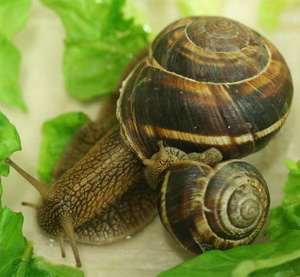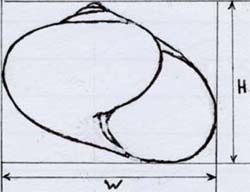|
A colleague, who works on fossil fishes in the Natural History Museum (Palaeontology Dept.), complained to me “Your wretched molluscs are eating all the flowers in my garden”. I denied responsibility and asked for details, particularly the size. A forefinger and a thumb indicated a shell about 3-4cm. He added “There seems to be two kinds”. So I asked for some empty shells, which eventually arrived on my desk. My colleague lives on London Clay with a light cover of Kempton Park gravels, about 300 metres north of Wimbledon Chase Station. The bag of shells did contain two kinds. Cornu aspersum, with its characteristic “beaten copper” shell texture, came as no surprise, on London Clay or any formation. The other was up to 1.5cm larger, lower spired, with prominent growth bands crossed by brown helical bands on a cream background. I had seven shells nearly all with one or more shell damage repairs; one had the shell ‘peeled’ back about 2cm and the previous whorl broken into. Natural justice for eating the flowers of my colleague! Two had a closed umbilicus, the rest with just a chink. Convinced that I had Helix pomatia living on London Clay, a matter of some interest since H. Pomatia is a well known calcophile, I asked for some shells with the living animal inside. Convinced also that the shells came from a French restaurant and were of no biogeographical significance, I was not hopeful. But there was no local French restaurant and a plastic box with two live specimens arrived on my desk. The larger of the two is a splendid ‘beast’ measuring 9cm from the mouth to the tip of the foot and a pale grey colour when fully extended. Still convinced I had Helix pomatia, the Roman Snail, I exhibited the empty shells and two living specimens at the October 2009 meeting of the Conchological Society. I am glad I did (figure 1, below). After some hilarious speculations as to how the Roman Snail got to Wimbledon, without help from a French restaurant, I suggested it was a hangover from the Roman occupation, when it was called ‘Wimbledonium’. Then, three members quietly told me it was not Helix pomatia but Helix lucorum (L.,1758). Further, H. lucorum was not on the British list, even as a casual introduction. Now it was looking serious and having spent more time looking at marine molluscs than terrestrials, I was clearly out of my depth. So, on the scientific principle ‘When in doubt, quantify’, some biometrics seemed appropriate. The trouble with measuring helical objects is that contact surfaces are never opposite and constant orientation is difficult. The table of measurements below (see also figure 2) gives some ides of overall size and height/width ratios in mm.
I wasn’t serious about ‘Wimbledonium’, but maybe the following hypothesis might explain this unexpected presence of a foreign snail. Someone, or a family, on holiday in eastern Europe, noticed the brightly banded shells, took a few home and found that some of the ‘empty’ shells had living animals inside and turned them out into the garden. My colleague has lived in his house for 14 years, so the snails are well established. If a Helix can survive the winters of eastern Europe, it would have no problem in milder ‘Wimbledonium’. I also now understand why gardeners rage against snails: keeping two specimens alive for four months, I learned of their love of lettuce. My thanks to Peter Topley for providing the photograph forming figure 1. |
Figure 2 |
Helix lucorum in Wimbledon, S.W. London
Issue
23
Page
12

 Figure 1: Helix lucorum from Wimbledon. (Photo taken at the Conchological Society’s NHM indoor meeting, 3rd October 2009)
Figure 1: Helix lucorum from Wimbledon. (Photo taken at the Conchological Society’s NHM indoor meeting, 3rd October 2009)